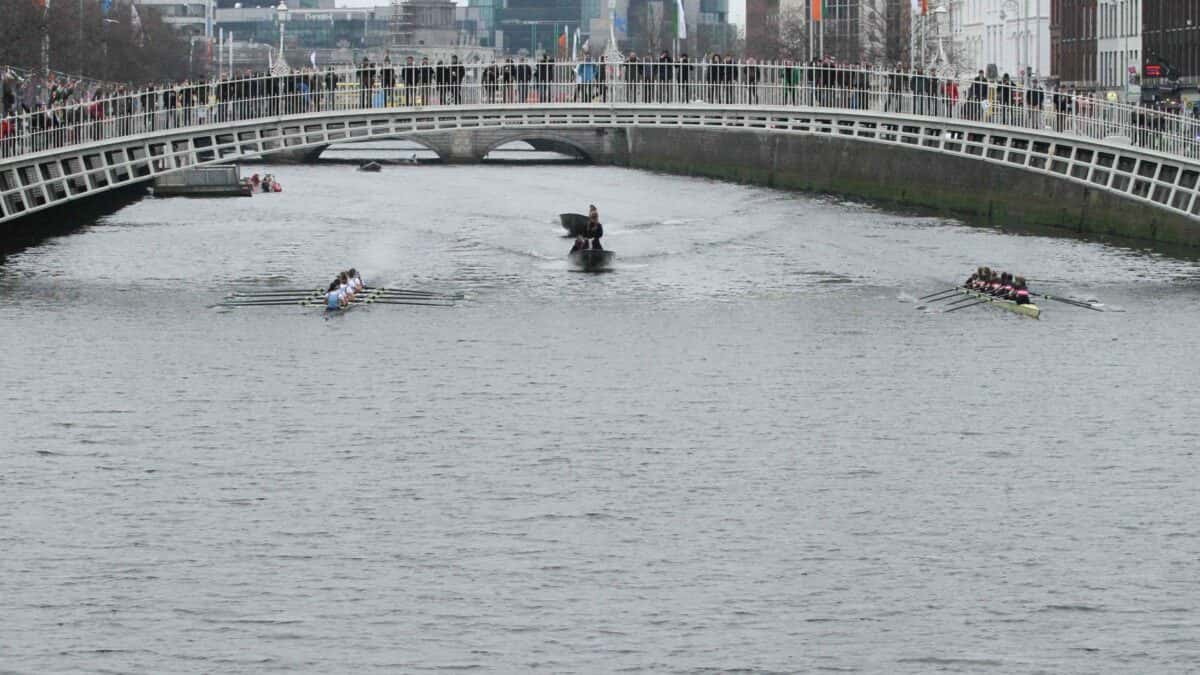
17 Mar 2015
Trinity and Dublin duel at Irish Boat Race
Known interchangeably as the Irish Boat Races, the Colours Race, or, more commonly, the Gannon Cup (after the Sr. Men’s trophy), the grudge match between these colleges saw its 67th edition on Saturday, 14 March 2015. Over the years the “Colours” rivalry has developed across many other sports, and the boat races have become an integral part of the City of Dublin’s St. Patrick’s Day festivities, drawing crowds in the thousands along the 2.2km stretch of the Liffey.
“All of Dublin is drawn into the race,” says Andrew Griffin, Men’s Vice Captain for the University College Dublin. Pedestrians cheer from the bridges and “a hoard of cyclists follow the race down the main road.” Despite the massive crowds, “the race can be very personal for those in the boats racing side by side,” Griffin explains.
The race itself has four events in eights for Senior and Novice Men and Women. Of the four trophies – the Corcoran Cup (Senior Women), Gannon Cup (Senior Men), Sally Moorhead Trophy (Novice Women), and Dan Quinn Shield (Novice Men) – the Gannon Cup was the first and has become synonymous with the event. This year is especially important as it marks the 100th anniversary of the birth of Ciarán Gannon, whose many years of dedicated service to the UCDBC before his death in WWII were commemorated in this race and this trophy.
And the result of the 2015 race? Trinity won all four events. “We had one of our most successful days on the Liffey,” says Trinity Men’s Captain, Ian Hurley. “Along with the ladies’ club we combined to win all four events for the first time ever. Winning the Gannon Cup for the first time in eight years, and in such a convincing manner, was a great way for the club to start the year.”
“It was a brave race by both crews,” says Trinity’s women’s coach Andrew Coleman.“And I know that it will be tight in three weeks when we line up on the start of the University Championships.”
Participation in the Boat Race, along with participation and performance throughout the season, is an integral step at both universities for athletes to earn their blazers. Winning “the Colours” moreover is filled with significance for students at both universities. “[The] Colours matters a lot,” says Hurley. “It is important to people within the university and even to alumni and people outside the university.”
“Winning Colours gets huge attention from the college,” agrees UCD’s Griffin, who also points out that “the winner at this event will usually be the main contender at the University Championships.”
Both clubs have a rich tradition of excellence and coach Coleman looks to that history to find inspiration and meaning. “I always think what makes Trinity, Trinity, is the sense of history you find as you walk through the door of the boathouse.” Pictures from as far back as the mid 1800s line the narrow hallway and speak to the same desires, fears, ambitions, and passions of rowers, coxswains, and coaches common to all within the sport, although the names and faces change with time and place.
There are trophies in some pictures, medals pinned like military honours to the vests and blazers of champion crews, but in others there are simply rowers, whose success lay in the struggle and the lessons learned through rowing that added to their lives. “The men and women who leave here have learned a lot,” says Coach Coleman. “Work hard and see improvement – this is the kind of ethos we bring into the sport.”
As the sport took shape across the sea in England with the first Boat Race in 1829 between Cambridge and Oxford, the Irish were right in step. In 1836 Trinity College formed their rowing club, with the University College Dublin joining them on the River Liffey, in 1917, shortly after the school was founded.
Both clubs now sit to the west of the city, upstream on the Liffey at Islandbridge in Phoenix Park, where their boathouses stand on opposite banks of the river. This small space houses six clubs and training space can be cramped, but the addition of a collaborative boathouse to store equipment eased the tension.
All through its long history, rowers have plied the Liffey’s waters, prying oars propelling kings and conquerors, patriots and presidents into the heart of this Irish land and the imagination of its people. The same cosmopolitan pulse of this ancient port city and the enthusiasm of students that saw the Liffey emerge as a cradle of the modern sport of rowing continue to give energy and hope through this annual challenge.
World Rowing will take a look at a different university club programmes each month to find out what makes them unique and what elements have contributed to their success. From student start-ups to Olympian production lines, is there a global definition of success in university rowing? If you think your university should be profiled, please contact us and tell us what sets your team apart: media@fisa.org

